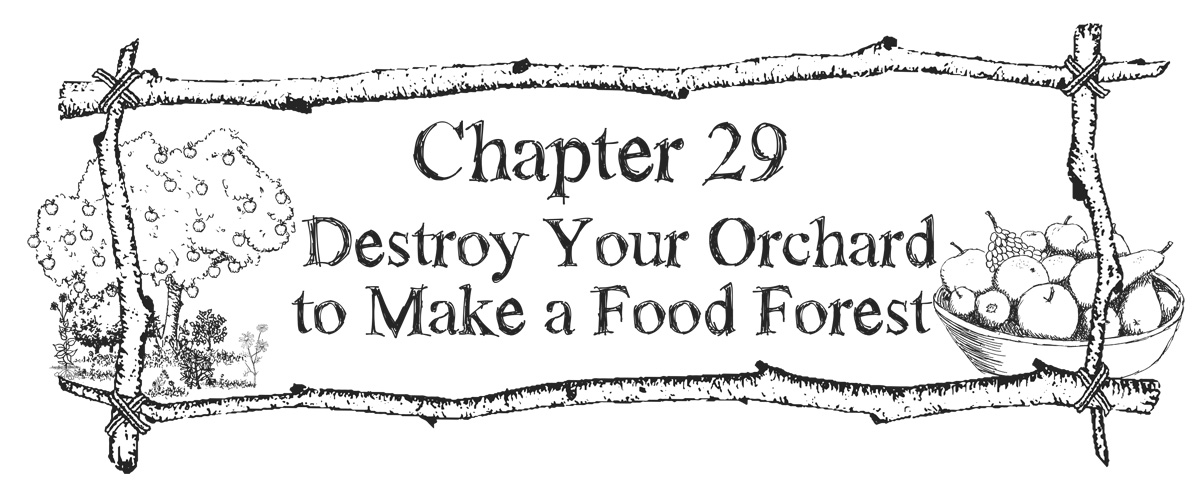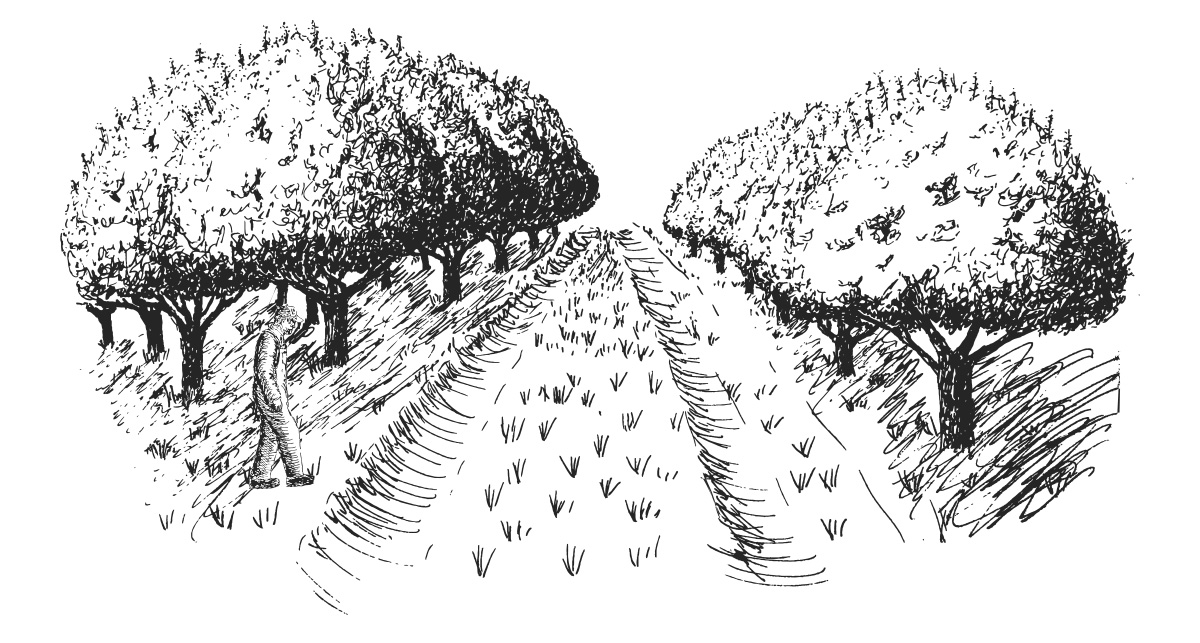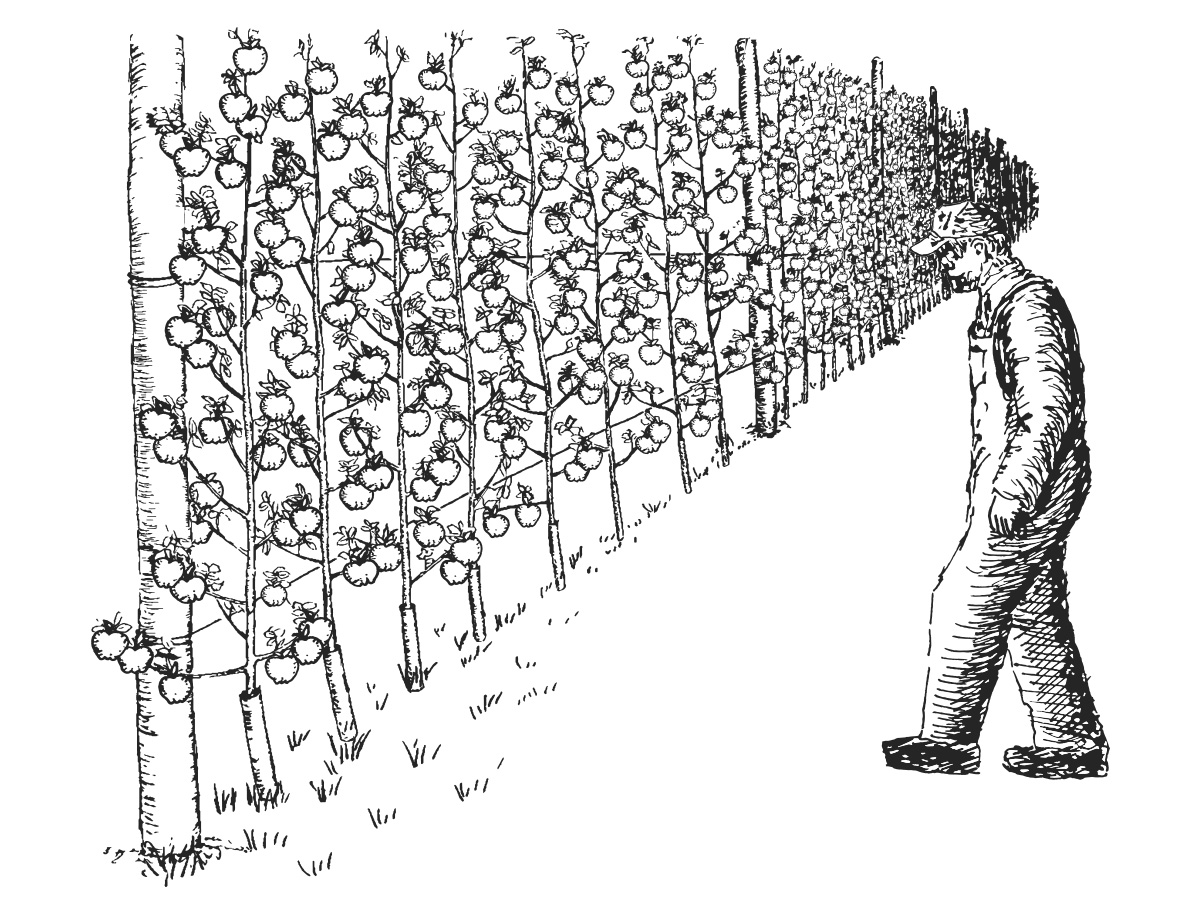
The most frustrating question I hear is “How do I turn my orchard into a permaculture orchard?” I tell people to start by cutting down 90% of their trees. Their counterpoint tends to feature harsh words and sometimes pitchforks and other stabby tools.
I think that when most people hear the word “orchard,” they think of a classic orchard with 15-foot-high (~5 meter) trees surrounded by neatly mowed grass.

But modern orchards look much different. The trees are planted on dwarf rootstock so that they are incapable of growing much more than 8 feet (~3 meters) tall. And the trees are trained into shapes that are so unnatural, they need wires to help hold up their branches.

I think that the term “permaculture orchard” is an oxymoron.1 An apple orchard, for example, is several rows of apple trees. A perennial monocrop. As with most monocrops, the plants (trees) all need the same things from the soil, and they all put the same exudates into the soil. If one plant gets hit with some sort of pest, it quickly spreads to all the others. Suddenly the insecticides and fungicides are looking mighty tempting.
But if we limit the number of trees of each species to no more than 10%, then the apple tree is surrounded by trees that are not apple trees. And instead of just trees surrounded by grass, we can include useful species from all seven layers of a forest: overstory, understory, shrubs, herbs, ground covers, root crops, and vines.2

The root exudate of these other species is food for the apple tree and the root exudate of the apple tree is food for the other species.3 Perhaps some of the neighboring trees are nitrogen-fixing species and are generous with their nitrogen. And perhaps another nearby plant creates a compound that repels certain pests and diseases, sharing it with other plants through the exchanges between roots and mycelium. The impact of pests and diseases is dramatically reduced.
If, despite our abundant polyculture, a particular tree gets taken out by pest or disease, then that means that nature did not want that tree there. It’s probably not worth the effort in trying to save it – we are better off working with nature than against nature.4
As mentioned earlier, I believe an important aspect of working with nature is to plant all of your growies from seed instead of transplanting. For starters, this approach avoids digging a hole for each tree and saves a lot of money on buying pre-grown trees. The main reason that I avoid transplanting is that, when you transplant your growies, they lose their tap root5 – a singular thick root that many plants have that anchors them in the ground and can reach water and nutrients that are too deep for shallow-rooted plants. It turns out that plants don’t like being moved and can take months or years to recover. Oftentimes, a tree planted from seed will catch up with a transplanted tree within three to five years.
By planting trees from seed, we are playing the lottery with plant varieties.6 We will find a few new cultivars that are terrible. We can cut those down and use that wood for a variety of other things. We will also find some new cultivars that are excellent. These new cultivars will work best with the conditions on our land, not some place far away with totally different conditions. This will make the trees more disease resistant, more insect resistant, healthier, and more productive than if we just bought some trees from the store and stuck them in the ground.
Pruning trees trains them to require further pruning. In an orchard, the trees are pruned at least once, if not multiple times, per year to get that perfect figure. It’s a lot of work. Masanobu Fukuoka7 tried to stop pruning his trees. The trees died. Then he planted new trees and pretty much never pruned them.8 The trees grew much bigger and were much healthier. They had a conelike shape with big branches right next to the ground, which left much less chance for things to grow under the tree and compete for nutrients.
The fruit of the “cone tree” is divided into three portions. The bottom portion is left to the critters and turned into eggs and meat (chicken, pork, duck, etc.); the middle portion is harvested for fresh eating, drying, juicing, and canning; and the top portion is left for the birds so they eat less of the stuff within easy reach of human harvesters. Some of that top fruit will eventually fall and become winter feed for your animals.9
Fruit left on the ground becomes a vector for pests and diseases. Animals eating that fruit eliminates that problem. Bacon-flavored pest control!
Rather than a harvest of one kind of fruit in an orchard, we can now harvest a hundred different products throughout a growing season with less work.